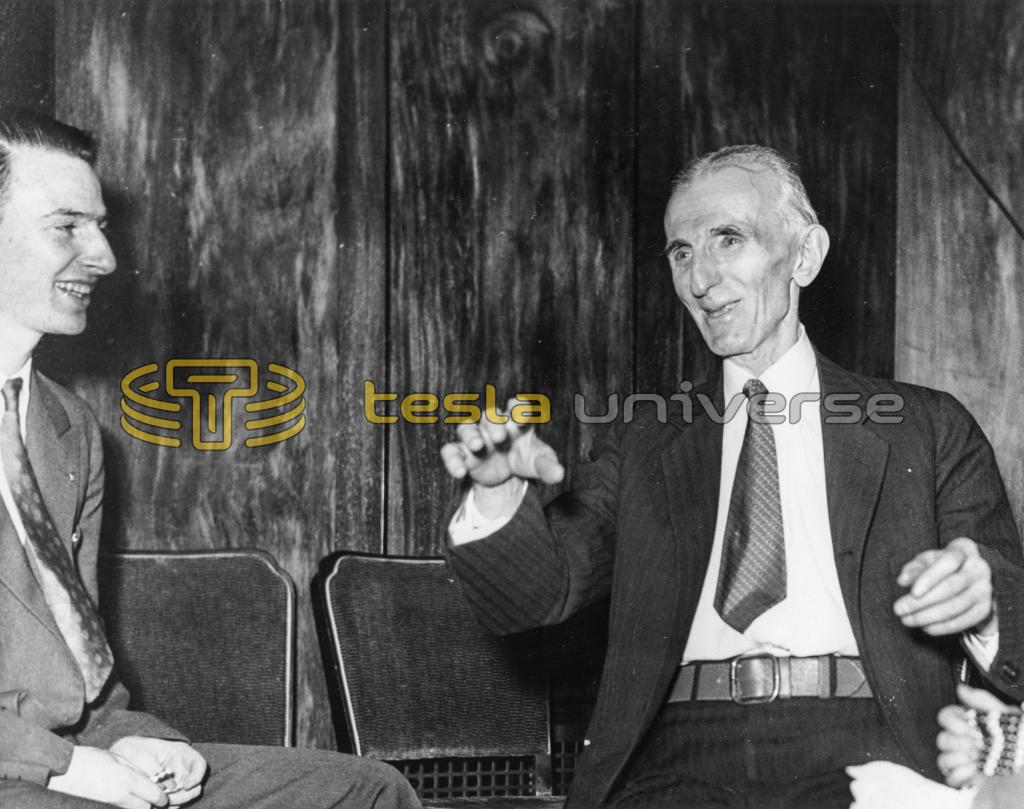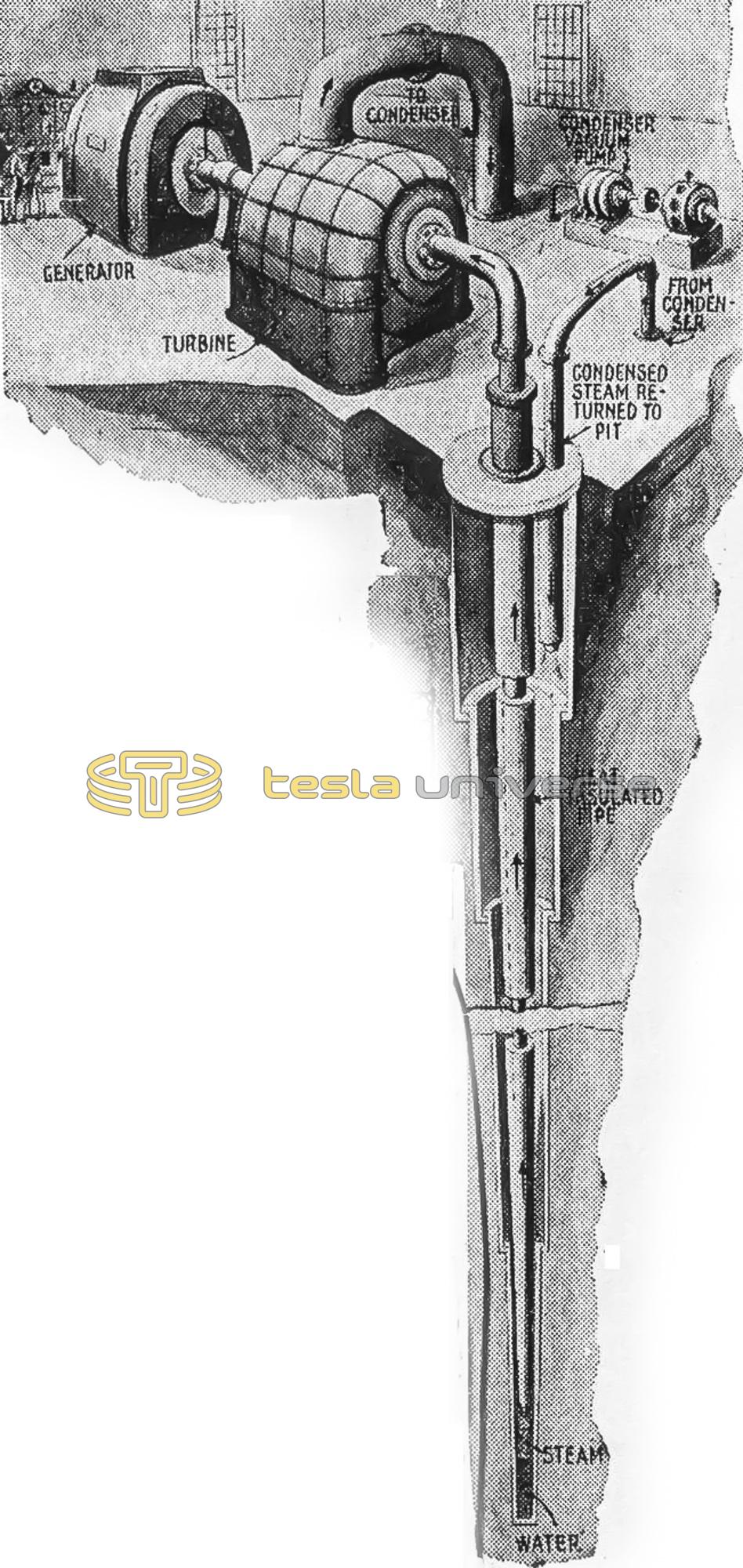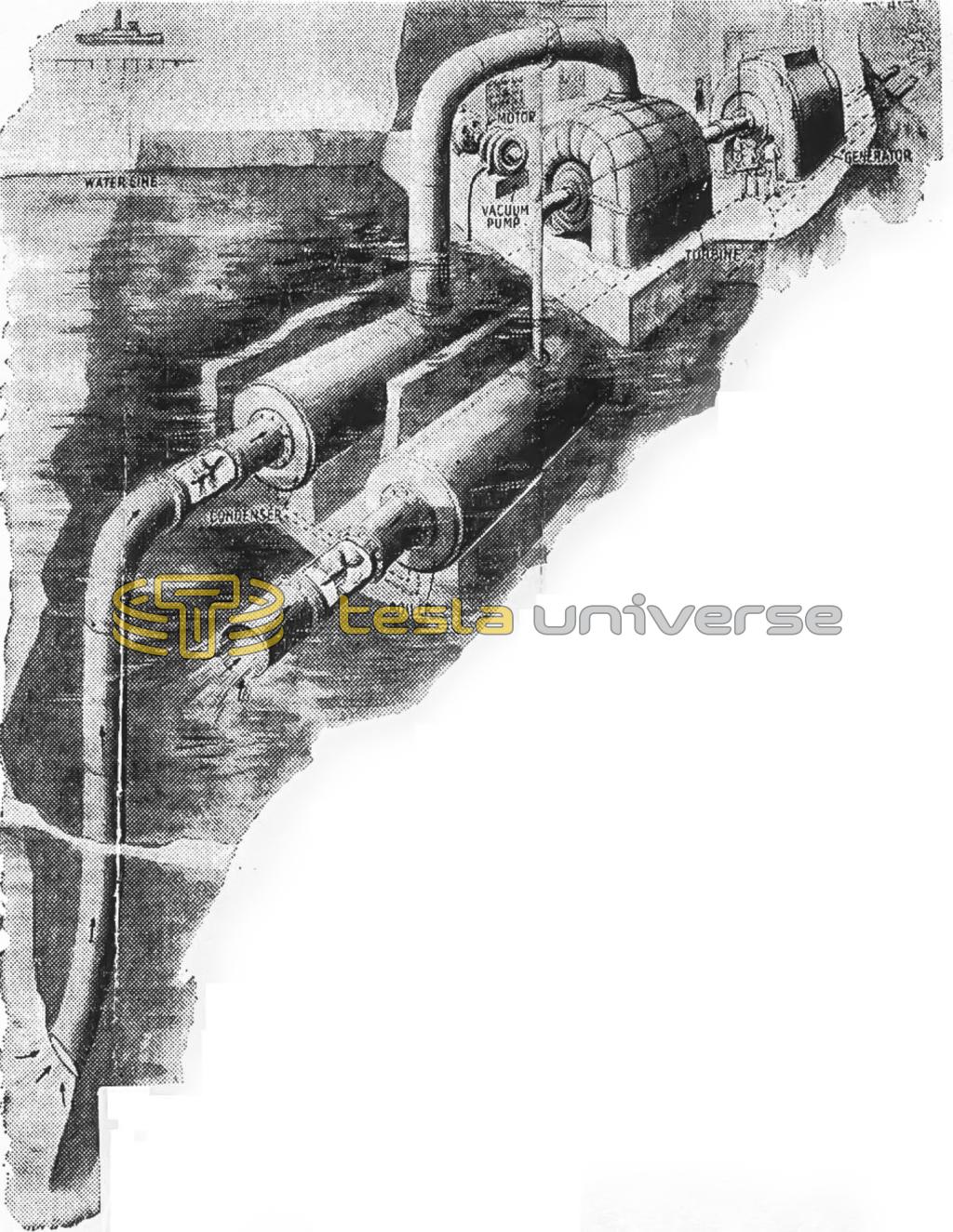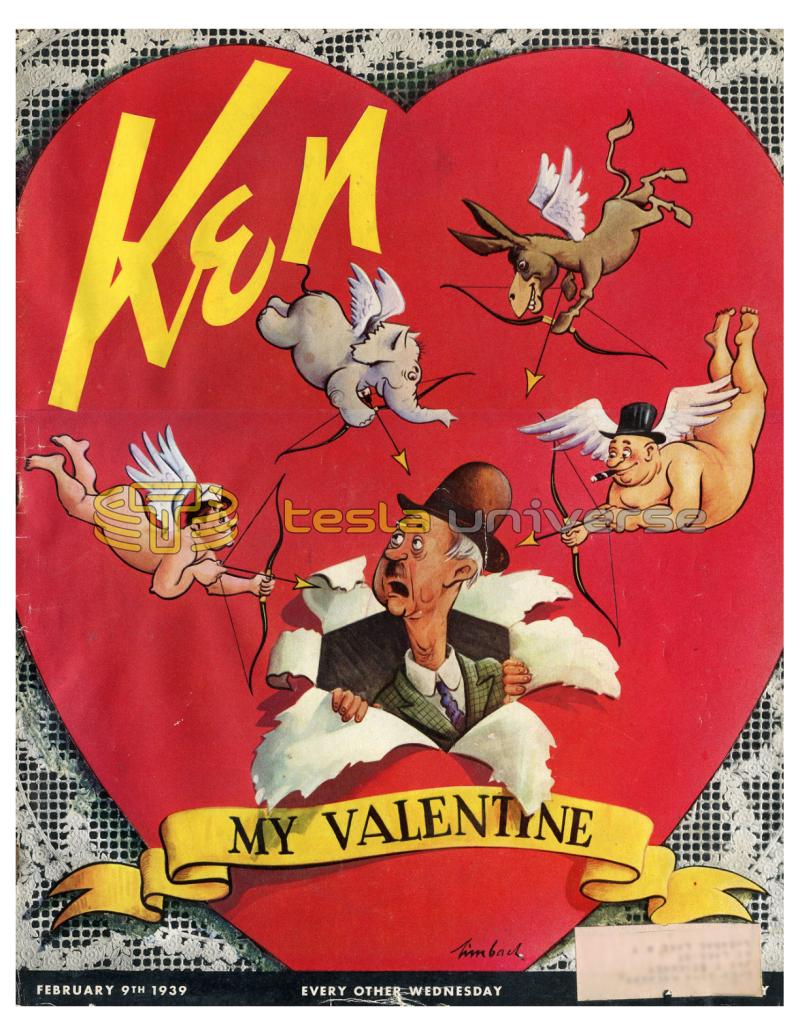
Nikola Tesla Articles
King of the Cosmos
Eccentric, 82-year-old Nikola Tesla talks more and has more to talk about than any other living inventor. Each year on his birthday he throws a party for the press at which he reads a paper on his achievements for that year. But Tesla's boasting is excusable, for the powerful electric plant at Niagara, quadruplex telegraphy, the rotating magnetic principle are numbered among his many contributions to modern science.
Nikola Tesla, 82, has been dubbed America's da Vinci of science. He has also been accused of out-Heroding Herod, preposterous daydreaming, crackpot thinking. If his legendary exploits have not been full hawked to the public, it is only because the Goldwyn touch is lacking. With what seems to have been the abracadabra flip of an imperial wizard, he has conjured single-handed out of his dynamic imagination, over 700 inventions, no two alike. He has quirks of genius to boot, sufficient stuff on the ball to perplex belittlers, credits to match the most prolific of inventive titans.
Not content with Manhattan, the giant has dabbled with America, Europe, Asia, the hemisphere, earth, planets, solar system. He has earned over a million and spent it just as rapidly on new will-o'-the-wisps. In recent years he has invented little of practical use, limiting himself to mental problems. Yet in full measure he continues to plague and confound authorities who cannot for the life of them understand why a man who has achieved so much should talk so much.
Each July on his birthday, Tesla throws a party for newspaper men, serves a palatable Scotch and reads a paper on his achievements for the year. Last year it was a method whereby humanity could communicate with the planets and produce dollar-a-pound radium. The year before there were three new inventions. The first, he stated, "would appear almost preposterous, the second would be considered absolutely impossible by any competent electrical engineer, the third would knock the props out from under the Einstein theory."
Tesla made his critics' eyes blink, when as a smashing climax to his 78th birthday, he divulged a death ray, perfected to the point where it could send, through the free air, concentrated beams of particles of such tremendous energy that a fleet of planes could be dropped 200 miles away, or instant death caused to armies of millions.
The New York Times has called Tesla one of the greatest inventors of all time. B. A. Behrend, an important electrical engineer, stated: "Were we to seize and eliminate from the industrial world the results of Mr. Tesla's work, the wheels of industry would cease to turn, our electric cars and trains would stop, our towns would be dead and idle."
The lean inventor holds honorary degrees from Yale, Columbia University, Vienna Polytechnic. In addition to the Edison Medal, he owns an Elliot-Cresson Medal given by the Franklin Institute.
]ugoslavians, in affixing a 72-napa stamp, lick the back of the inventor's likeness. King Peter honored him with the Grand Cordon of the White Eagle, highest Jugoslavian civil order. He has been publicly lauded by Sir Oliver Lodge, Lee De Forest, Lord Kelvin, John Hays Hammond, Jr., H. H. Westinghouse, Dr. Robert A. Millikan, former Secretary of Commerce Lamont and others. Delegations of European scientists have visited his birthplace to tender homage.
Tesla designed the powerful plant that first harnessed Niagara, thought out the famous Tesla coil, an electric transformer, without which the web of hot voltage wires crisscrossing the country would have been impossible. He discovered the quadruplex method of telegraphy whereby a number of messages could be flashed simultaneously over a single wire. The rotating magnetic field principle which produced the split-phase induction motor and alternating current, is Tesla's work. Other practical inventions have included generators, a better lightning rod than Franklin's, a combined helicopter and airplane, an arc light, a bladeless turbine, a new speed indicator, pressure vacuum pumps and the first major improvement in water fountains since the Italian Renaissance.
The facile inventor lives alone in a large invention-cluttered room on the 33rd floor of metropolitan Hotel New Yorker. During the winter, temperature in the room remains between 90 and 95°. Doors and windows are taped and sealed to exclude fresh air. The thin inventor goes about in a suit of ankle-clutching underwear, woolen golf hose, high-laced brogans. He dons a dressing robe when maids knock and seldom stirs from the room, although in earlier days he walked ten miles daily.
His eccentricities also extend to his food. Once an accomplished gourmet, he now munches vegetables, occasional Valencia oranges and two quarts of milk daily, which he prepares on his own double boiler. He is extremely touchy about the vegetables. Only two special chefs are allowed to tamper with the greens which must be boiled two hours or longer. Even then a struggle ensues to convince the inventor that they are not half raw.
Over six feet, sparse, with long thin arms and hands, Tesla's appearance is still striking. His ascetic face, broad and bony at the temples, bulges between the eyes, tapers sharply to nervous lips, emphatic chin. Eyes are a hypnotic light blue-gray, set deep in cavernous sockets. He expects to reach 135 and points to the longevity of his ancestors, none of whom touched the mark he has set for himself.
Two strong dreams have plagued the wizard throughout his long life — a system of wireless communication and a method of transmitting electrical energy without wires, They background his most fantastic projects, many of which smack of popular scientific thrillers. The inventions have never been fully realized, although they are fully patented and seem to have had successful minor tests.
There was a time when fulfillment of the great dreams seemed assured. It was during the late Eighties, when one American home in 30 bore electric lights, there were 8000 gas buggies snorting around, and wireless was only a faint wheeze in the ether.
Tesla and Marconi were feverishly racing against time to perfect wireless. The young Italian drew quarters in the marine station at Signal Hill, St. John's, Newfoundland; Tesla, the tip of Pikes Peak, Colorado, Their systems, similar in many respects, differed in that Marconi relied upon the ether to conduct his waves, while Tesla made use of the earth as a conductor.
Around them humanity plodded on its daily round, completely unaware of the battle between the titans — one stooped over a primitive spark transmitter within earshot of the fuming Atlantic: the other posted on a lofty mountain, matching the blazing storms with crackling bolts of homemade lightning.
In 1899, Tesla jolted the nation with a sensational announcement which seemed like extravaganza hatched jointly out of Barnum and Verne, "I have received," stated the inventor, "faint extraplanetary signals whose measured regularity was such that they could not have been accidental. I signaled back with my powerful radio transmitter and am certain that I produced a disturbance on Mars!"
The freak statement did much to arouse popular interest in the obscure wireless. All editorial in a leading newspaper reprimanded Tesla with the remark that unfortunately for the inventor's scientific standing, he had not adduced a scrap of evidence to prove it. The inventor stubbornly stuck to his statement.
An obvious inference — that Tesla's apparatus might have picked up Marconi's wandering signals — has never been pointed out.
Fired by the success of his experiments, Tesla dashed back to New York determined to give his dream a practical test on a large scale. He convinced the elder Morgan to help out, sent agents to scour the British coast for a possible site and hurried down to Long Island, where 200 acres of land had been purchased in Wardenclyffe, now Shoreham, about 65 miles from New York City.
That rural village, situated cozily on the edge of Long Island Sound, boasted a population of 100. All of it was startled when the local builder received orders one morning to erect a number of wooden frame houses. When they were completed, a train chugged into the town disgorging a horde of workmen who occupied the cottages and set to work clearing ground. More trains arrived with several hundred workmen in all.
A number of brick factory buildings began to rise, the largest 100 feet square, several stories high. Flat and freight cars emptied supplies and fantastic-looking machinery carefully crated — huge steam boilers in sections, elephantine engines coated in grease, transformers, generators were laboriously dragged into the main structure and installed by a gang of silent, swift-working men.
Near the brick structure a monster began to rear. Of steel lattice work nearly 200 feet high, it was hooded in the shape of a gigantic toadstool capped with a circular dome of copper filigree. Workmen admitted, when no one was looking, that pipes 185 deep had been gouged into the earth, and an underground passage with conduits led from the laboratory to the tower base.
Wardenclyffe had never seen such a to-do. Each day the population came as close to the scene as was permitted and gawked surmises. Delegations from the neighboring towns of Baiting Hollow, Wading River and Miller Place abandoned their potato and cauliflower beds to see for themselves. Wild rumors circulated. Some maintained the plant would furnish power for New York, others that it would be a main signal station connecting with Europe and Australasia. More imaginative souls who believed the inventor intended communicating with Mars stepped into their backyards at night, shook their heads and marveled at the white speck in the sky which was 248 million miles from their kitchens.
The cause of all the excitement kept aloof. When not prowling about supervising the supervisors, he disappeared into a cottage and refused to come out. Interviews to newspapers, magazines and villagers were politely, but firmly refused.
Each morning at the old Waldorf-Astoria, the chef carefully packed a thermos container with a special luncheon and dispatched it by noon train to Wardenclyffe for Tesla's finicky consumption.
When the tower and buildings were completed, excess workmen returned to the city. Tesla vanished into the laboratory with a group of picked technicians. Visitors were barred by stern-lipped guards. A roar of dynamos began, and the flicker of weird fires during the night.
Suddenly, almost in a day, the sorcerer and his apprentices departed. The constant chirp of crickets replaced the droning dynamos; the night was as it had always been. Windows and doors were boarded fast.
For a while a lone watchman kept vigil, then even he left.
Wardenclyffites gossiped, became used to the deserted plant, paid no attention to the fantastic colossus looming darkly against their horizon. Snow and wind shrilled through the lattice work; rust ruined the steel. Adventurous Tom Sawyers shinned the lower until the struts rotted.
A full dozen years later the buildings remained untouched — suspended in time as if unseen forces had swiftly descended and plucked the plant of its life. Drawers and desks had been yanked open, papers scattered over the floor; dead clinkers lay gray and stiff in the furnace grates; glass retorts and apparatus, fallen from supports, hung cracked and crooked. Only the constant engineering of spider webs went inaudibly on within the stricken hulk. "Tesla's Folly" had cost nearly $200,000.
The tower stood until America entered the War. When the spy hysteria seized the country and enemy radios were reported concealed and operating from tree trunks and back-yard piazzas, the citizens of Wardenclyffe begat the jitters. Rumor had it foreigners were lurking around, using the tower to contact German submarines off the Atlantic seaboard.
One night Government agents swooped down, found no spies, but decided to take no chances. Charges of dynamite were exploded under the foundations and the tower keeled over into junk.
To this day Jugoslavians disagree violently that Marconi invented wireless telegraphy. They claim the Italian only utilized Tesla's basic system.
Nikola Tesla was born in Smiljan, border country of Austria-Hungary, not far from the eastern Adriatic coast. His father was a Serbian Orthodox clergyman, son of an officer who served with the grand army of Napoleon but who subsequently became a preacher. Tesla's mother, Georgina Mandic, came from an inventive family. Her son once boasted that when she was past 60 her fingers were still nimble enough to tie three knots in an eyelash.
As a stripling, the inventor was sharp-featured, frail, intense, destined by parental choice for the clergy. He rebelled early, thought of teaching mathematics and physics, finally switched to engineering, He nearly died twice before he achieved manhood, once from a severe attack of cholera, later, the result of over-study, from a severe nervous breakdown. Family connections led to a job in Budapest, but Tesla, impatient at 23, went to Paris, where he landed work as an engineer with an electric light company. He met many Americans there, heard more about the great Edison and of the ready encouragement given to inventors with practical ideas. In 1884 he headed for the fabulous States. Five years later he became a citizen.
In New York he gravitated naturally into the workshops of Edison, then located on Goerck Street in the heart of the teeming East Side. The association with the wizard of Menlo Park was none too happy. They worked on different tacks, Edison for direct current, Tesla for alternating. When the plant manager failed to fork over a bonus he had promised, Tesla quit, less than a year after he had entered.
Alternating current seemed doomed to extinction despite Tesla's constant efforts and enthusiasm. Few electrical engineers had worked with it; a majority were unfamiliar even with its essential features, At a most opportune time, laboratory tests by Professor Anthony of Cornell revealed that the revolutionary system had an efficiency equal to that of direct current.
Tesla became the prophet of the early 20th century. His incredible forecasts, many of which were ahead of his time, titillated popular imagination. Among them were television, smoke-annihilators, dust-absorbers, ozonizers, gyroscopes on ocean liners, electric refrigerators for home use.
He prophesied the household's daily newspaper would be printed during the night by wireless, an invention that had its first successful test in recent months. More than 35 years ago, Tesla discovered the principle of neon lamps as now used.
His appearance in print and on the lecture platform provoked unmerciful attacks. One article stated that all his "wonderful experiments" were extensions of familiar ones shown on lecture tables by the ordinary teacher of physics.
Another warned all sober-minded readers that "Mr. Tesla's recently published utterances have discredited him in the eyes of contemporary judges — philosophic and social problems upon which he freely expressed a jumble of trivial, ignorant and pretentious and erroneous opinions. His vivid writings must be read with extreme caution. His speculations on science are so reckless as to lose an interest. His philosophizing is so ignorant as to he worthless."
Adverse opinions, however, have seldom bothered the inventor. He even stated at one time that he derived a feeling of satisfaction from opposition. He has lived to confound his enemies and even to read many of their obituaries with regret.
Grown more temperamental and less communicative in recent years, something of a metaphysician and poet, Tesla prefers to brood in solitude. Strict orders are at the hotel desk not to disturb him before noon. Last winter he was severely ill, but has since recovered.
This year, for the first time, he postponed his party to the press. The reason, he stated, was a mechanical therapeutic device, almost completed, which would cure many internal disorders.
He also expects to announce this year another invention outside his field, something that will benefit the one billion-a-year poultry industry, and improve the size, quality and quantity of eggs and chickens.



